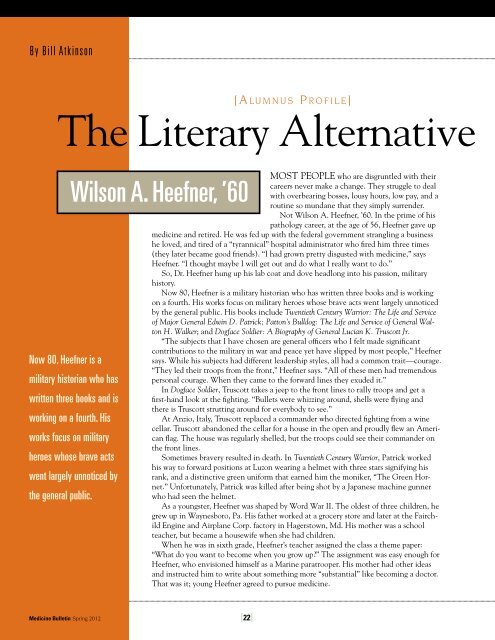Medical Alumni Association of the University of Maryland
Medical Alumni Association of the University of Maryland
Medical Alumni Association of the University of Maryland
You also want an ePaper? Increase the reach of your titles
YUMPU automatically turns print PDFs into web optimized ePapers that Google loves.
By Bill Atkinson<br />
[ALUMNUS PROFILE]<br />
The Literary Alternative<br />
MOST PEOPLE who are disgruntled with <strong>the</strong>ir<br />
careers never make a change. They struggle to deal<br />
with overbearing bosses, lousy hours, low pay, and a<br />
routine so mundane that <strong>the</strong>y simply surrender.<br />
Not Wilson A. Heefner, ’60. In <strong>the</strong> prime <strong>of</strong> his<br />
pathology career, at <strong>the</strong> age <strong>of</strong> 56, Heefner gave up<br />
medicine and retired. He was fed up with <strong>the</strong> federal government strangling a business<br />
he loved, and tired <strong>of</strong> a “tyrannical” hospital administrator who fired him three times<br />
(<strong>the</strong>y later became good friends). “I had grown pretty disgusted with medicine,” says<br />
Heefner. “I thought maybe I will get out and do what I really want to do.”<br />
So, Dr. Heefner hung up his lab coat and dove headlong into his passion, military<br />
history.<br />
Now 80, Heefner is a military historian who has written three books and is working<br />
on a fourth. His works focus on military heroes whose brave acts went largely unnoticed<br />
by <strong>the</strong> general public. His books include Twentieth Century Warrior: The Life and Service<br />
<strong>of</strong> Major General Edwin D. Patrick; Patton’s Bulldog: The Life and Service <strong>of</strong> General Walton<br />
H. Walker; and Dogface Soldier: A Biography <strong>of</strong> General Lucian K. Truscott Jr.<br />
“The subjects that I have chosen are general <strong>of</strong>ficers who I felt made significant<br />
contributions to <strong>the</strong> military in war and peace yet have slipped by most people,” Heefner<br />
says. While his subjects had different leadership styles, all had a common trait—courage.<br />
“They led <strong>the</strong>ir troops from <strong>the</strong> front,” Heefner says. “All <strong>of</strong> <strong>the</strong>se men had tremendous<br />
personal courage. When <strong>the</strong>y came to <strong>the</strong> forward lines <strong>the</strong>y exuded it.”<br />
In Dogface Soldier, Truscott takes a jeep to <strong>the</strong> front lines to rally troops and get a<br />
first-hand look at <strong>the</strong> fighting. “Bullets were whizzing around, shells were flying and<br />
<strong>the</strong>re is Truscott strutting around for everybody to see.”<br />
At Anzio, Italy, Truscott replaced a commander who directed fighting from a wine<br />
cellar. Truscott abandoned <strong>the</strong> cellar for a house in <strong>the</strong> open and proudly flew an American<br />
flag. The house was regularly shelled, but <strong>the</strong> troops could see <strong>the</strong>ir commander on<br />
<strong>the</strong> front lines.<br />
Sometimes bravery resulted in death. In Twentieth Century Warrior, Patrick worked<br />
his way to forward positions at Luzon wearing a helmet with three stars signifying his<br />
rank, and a distinctive green uniform that earned him <strong>the</strong> moniker, “The Green Hornet.”<br />
Unfortunately, Patrick was killed after being shot by a Japanese machine gunner<br />
who had seen <strong>the</strong> helmet.<br />
As a youngster, Heefner was shaped by Word War II. The oldest <strong>of</strong> three children, he<br />
grew up in Waynesboro, Pa. His fa<strong>the</strong>r worked at a grocery store and later at <strong>the</strong> Fairchild<br />
Engine and Airplane Corp. factory in Hagerstown, Md. His mo<strong>the</strong>r was a school<br />
teacher, but became a housewife when she had children.<br />
When he was in sixth grade, Heefner’s teacher assigned <strong>the</strong> class a <strong>the</strong>me paper:<br />
“What do you want to become when you grow up?” The assignment was easy enough for<br />
Heefner, who envisioned himself as a Marine paratrooper. His mo<strong>the</strong>r had o<strong>the</strong>r ideas<br />
and instructed him to write about something more “substantial” like becoming a doctor.<br />
That was it; young Heefner agreed to pursue medicine.<br />
Wilson A. Heefner, ’60<br />
Now 80, Heefner is a<br />
military historian who has<br />
written three books and is<br />
working on a fourth. His<br />
works focus on military<br />
heroes whose brave acts<br />
went largely unnoticed by<br />
<strong>the</strong> general public.<br />
Medicine Bulletin Spring 2012 [22]



